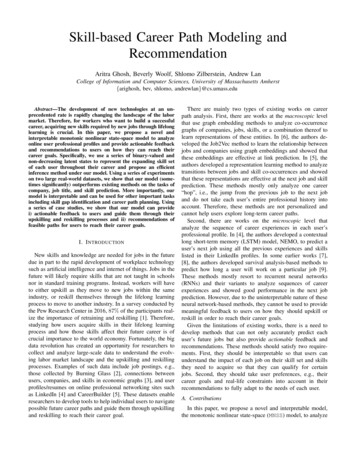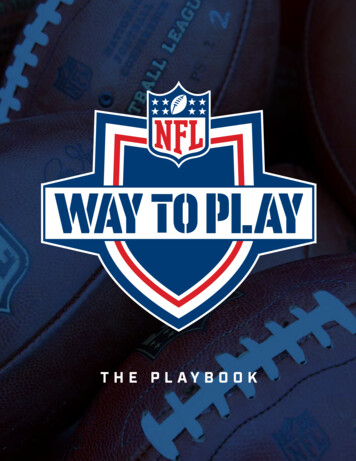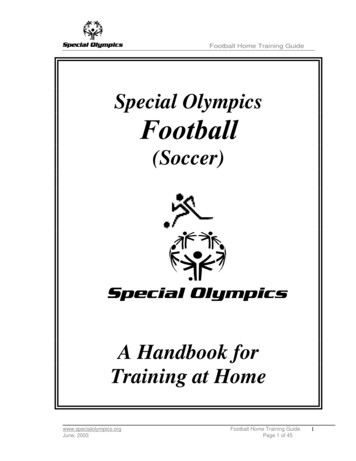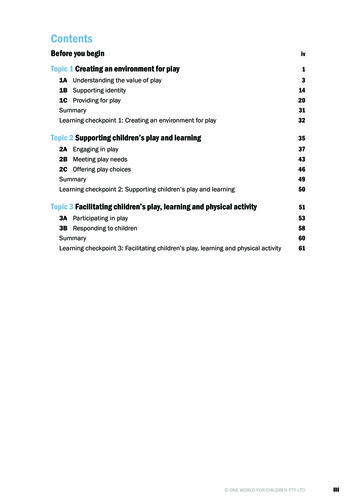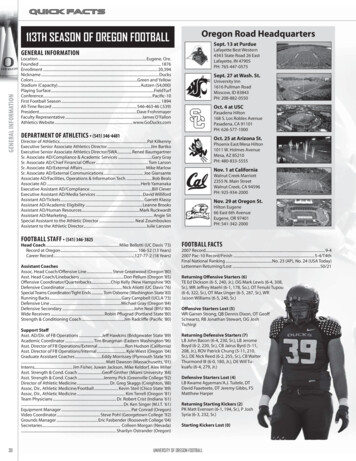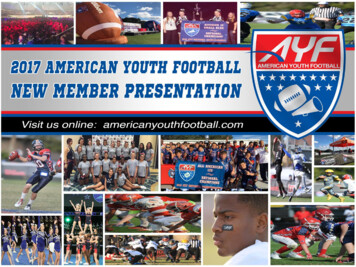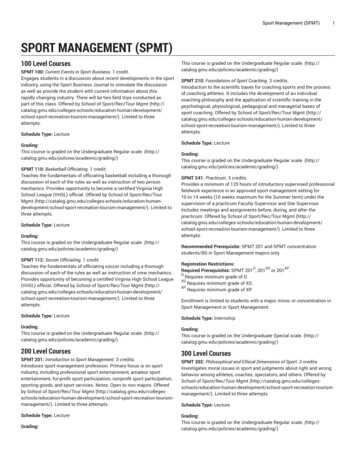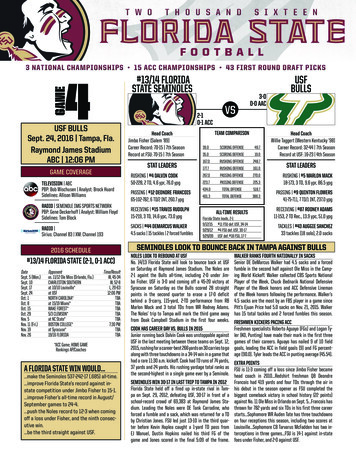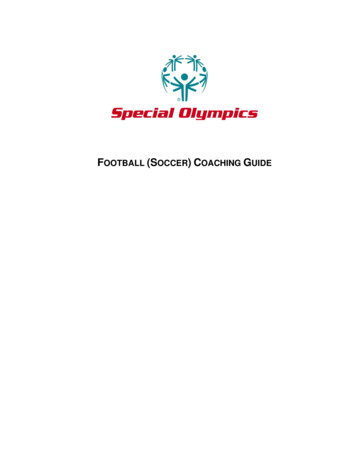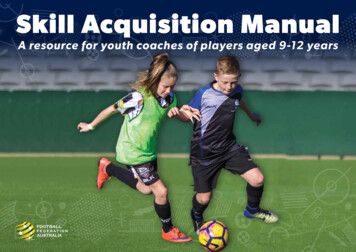
Transcription
Skill Acquisition ManualA resource for youth coaches of players aged 9-12 years
FOOTBALL FEDERATION AUSTRALIATECHNICAL DEPARTMENTJULY, 2018National Technical Director - Eric AbramsGirls Youth Development Manager - Debbie FisherBoys Youth Development Manager - Kevin Grima
CONTENTS4567810Forewordby Emma Highwood, Head of Community, Football Development & Women’s Football35Core Skills in Attack and Defence36Game-Intervention-Game (GIG) MethodologyPreface by Eric Abrams, FFA National Technical Director56C.H.A.N.G.E.I.T57Constraints-based Coaching ModelFFA’s Vision and Philosophy58Term Planner62Example SessionsThe Building BlocksSkill Acquisition Phase (9-12 Years)Playing Formats24Skill Acquisition Phase Coaching Guidelines34Principles of Play9666First Touch72Striking the ball78Running with the ball841v190GoalkeepingBibliographySKILL ACQUISITION MANUAL 3
FOREWORDIn 2015, Football Federation Australia launched the Whole of Football Plan (WOFP) with a set of ambitious, yet tangible goals thateveryone in Australian Football could work towards over the next 20 years. In developing this plan, we held a firm conviction thatFootball's best years were ahead of us.A first step was the design of FFA’s 4 Year Strategy Plan (2016-2019) which is made up of four pillars with key targets:1. Connect more fans with the Hyundai A-League and Westfield W-League2. Improve the experience for all participants3. Build generations of successful National Teams4. Lead towards a unity of purposeThe FFA Skill Acquisition Manual: A resource for youth coaches of players aged 9-12 years has been developed to reflect our shared football vision by givingcoaches a tool to help engage as many boys and girls as possible to have an enjoyable and memorable football experience. For some, it will form part of thejourney to play in the Hyundai A-League or Westfield W-League and potentially one day represent the Caltex Socceroos or Westfield Matildas.I’m delighted to formally publish this document and thank the entire FFA team and all State and Territory Member Federations for their input in its development.I look forward in witnessing the continual growth of the game and seeing all boys and girls developing a love for the game by having a truly enjoyable, positiveand educational football experience.Emma HighwoodFFA Head of Community, Football Development & Women’s Football4 SKILL ACQUISITION MANUAL
PREFACEIt is with great pleasure that I present FFA’s Skill Acquisition Manual: A resource for youth coaches of players aged 9-12 years. TheSkill Acquisition Phase is the ‘Golden Age of motor learning,’ making it an important stage of technical development. This manualaims to provide youth coaches with the necessary tools to create developmentally appropriate practical sessions that are inclusiveof all Australian girls and boys aged 9-12 years who have a passion and interest to play football.During my time as National Technical Director, I have observed numerous Skill Acquisition practical sessions around the country and witnessed some qualitycoaching. However, it is evident that children in this development stage need to be exposed to more activities that closely resemble the demands of the realgame. Creating FUN games in practical sessions will grow children’s passion for football and keep them in our beautiful game for life. Exposing children tomore games in practical sessions will also help ‘develop thinking players’ to make appropriate decisions for themselves in matches.The Game-Intervention-Game (GIG) methodology presented in this manual taps into children’s inherent desire to play more games. It encourages decisionmaking and more game-specific ball contacts during practical sessions. The approach presented in this methodology provides opportunities for the coach toutilise both ‘Game Sense’ (implicit learning) and ‘explicit’ (teaching technique with supporting feedback) coaching methods to facilitate a FUN ‘player-centred’approach to football development.Youth coaches play an integral role in raising the overall standards of football in Australia, therefore developing a larger pool of potentially talented players torepresent the Westfield Matildas and Caltex Socceroos. I am confident that Australian youth coaches will adopt this approach as we work together to contributetowards developing better football players for the future.Eric AbramsFFA National Technical DirectorSKILL ACQUISITION MANUAL 5
FFA’S VISION AND PHILOSOPHYFootball Federation Australia has articulated a National Playing Style Statement in the National Football Curriculum (NFC)which strongly considers and accommodates the Australian football context:A proactive brand of football, based on effective possessionwith the cutting edge provided by creative individuals.Defensively the key components are quick transitionand intelligent collective pressing.The Playing Style is underpinned by a strong ‘team mentality’,capitalising on Australia’s traditional strengths.This National Playing Style Statement provides a focus for all Australian football coaches in developing players and teams that are able to execute our brandof football. Having an overarching National Playing Style enables youth coaches to see the bigger picture and make positive contributions in nurturing youthplayers to develop the technical, tactical, mental and physical skill-sets required to become confident players in the future. This shared vision will also play anintegral part in raising the overall standards of football and develop generations of quality footballers in our country.6 SKILL ACQUISITION MANUAL
THE BUILDING BLOCKSAGE4 TRAININGBUILDING BLOCKS2 PLAYINGBUILDING BLOCKSAGEFor the purpose of this manual, we will only look at theSkill Acquisition Phase Training Building Block and theSmall-sided Football Playing Building Blocks. The GameTraining Phase and Discovery Phase Training BuildingBlocks are covered in greater detail in the National FootballCurriculum together with the 11 v 11 Building Block.PerformancePhase16Game TrainingPhase11 v 11121612DiscoveryPhase5The FFA Building Blocks Methodology is theframework that provides practical guidelines forcoaches working at all levels of youth developmentin order to help them in answering questionssuch as: What are the mental and physical characteristics ofplayers in the various development stages? What type of practices are best suited for specific agegroups and why?Skill AcquisitionPhase9The FFA National Football Curriculumdistinguishes 6 Building Blocks: 4 TrainingBuilding Blocks and 2 Playing Building Blocks. How long should a session go for and how often shouldI train?Small-sidedFootball9 How do I plan and design my sessions? What are points of interest when I coach my teamduring matches?5SKILL ACQUISITION MANUAL 7
SKILL ACQUISITION PHASE (9-12 YEARS)AGE4 TRAININGBUILDING BLOCKS2 PLAYINGBUILDING BLOCKSAGEPerformancePhase1612Game TrainingPhaseDiscoveryPhase58 SKILL ACQUISITION MANUAL If the player does not gain this skill foundation duringthis phase it will be very difficult to make it up later No amount of fitness or competitive spirit will evercompensate for deficiencies in functional game skills11 v 111612SKILLACQUISITIONPHASE9 In the Skill Acquisition Phase the coach must focuson providing a solid foundation of game-relatedtechnical skillsSmall-sidedFootball95
SKILL ACQUISITION PHASE (9-12 YEARS)Children this age are usually: highly motivated and enthusiastic competitive, like challenges and want to show they’re the best well balanced and coordinated adaptive to learning motor skills still self-centered, they start to learn how to work together sensitive to criticism and failure (praise is important) physically and mentally ready for a more structured approach to trainingAs mentioned above, in the period before entering the growth spurtthat goes hand in hand with puberty, children are well balanced andcoordinated. This makes them very adaptive to developing motor skills(techniques) especially since this is one of the brain’s key developmentperiods. Some children, in particular girls, will be going through the growthspurt during this period so the coach must take this into consideration asthey will be experiencing major physical and emotional changes duringsuch time.Motor development experts call this phase of ‘turbo charged’ technicaldevelopment: the ‘Golden Age of motor learning’. In no otherdevelopment phase in life will motor learning happen faster than here.As a logical consequence of the above, it makes sense that we optimise thisperiod to lay a sustainable technical foundation to develop more confidentand technically proficient players.SKILL ACQUISITION MANUAL 9
PLAYING FORMATS10 SKILL ACQUISITION MANUAL
SKILL ACQUISITION MANUAL 11
PLAYING FORMATS7v7 Playing Format: Attacking/Ball Possession (BP)Created using SoccerTutor.com Tactics Manager12 SKILL ACQUISITION MANUAL9-10YEARS7v7 Playing Format: Defending/Ball Possession Opponent (BPO)Created using SoccerTutor.com Tactics Manager
PLAYING FORMATS9-10YEARS7V7 PLAYING FORMATRecommended field size: 45 metres x 35 metresRecommended goal size: 3 metres wide x 2 metres highRecommended penalty box size: 5 metres deep x 12 metres wideRecommended playing shape: 1-2-1-3 in attacking (BP)Goalkeeper (1), Fullbacks (2, 5), Holding Midfielder (6), Central Striker (9) and Wingers (7, 11)Playing this shape encourages goalkeepers to play off their line and connect with the full backs and midfielderShape is dynamic in attacking (BP) and defending (BPO), not staticSKILL ACQUISITION MANUAL 13
PLAYING FORMATS9-10YEARS7v7 Passing TrianglesCreated using SoccerTutor.com Tactics Manager14 SKILL ACQUISITION MANUAL
PLAYING FORMATSWHY PLAY 7V7? rovides individual players with more ball contacts inPeach match by dribbling, running with the ball, short/medium passing and striking the ball9-10YEARS oalkeeper (1), Fullbacks (2, 5), Holding MidfielderG(6), Central Striker (9) and Wingers (7, 11) laying in this shape instead of 1-3-3: Goalkeepers arePencouraged to stay engaged with defenders and themidfield player provides connection between the lines Opportunities to engage in 1v1 duels across the field of play There is width and depth across the playing area in attack ore ball contacts also mean more moments andMopportunities for decision making he focus is more on football skills rather thanTon physical qualities Recommended playing shape: 1-2-1-3 This represents all lines of the 11 v 11 gameI t encourages playing diagonal passes through betterangles of support It offers spaces to penetrate with and without the ball hen creating chances, there are numerous players inWthe scoring zone he shape is dynamic in attacking (BP) and defendingT(BPO), not staticSKILL ACQUISITION MANUAL 15
PLAYING FORMATS9v9 Playing Format: Attacking/Ball Possession (BP)Created using SoccerTutor.com Tactics Manager16 SKILL ACQUISITION MANUAL11-12YEARS9v9 Playing Format: Defending/Ball Possession Opponent (BPO)Created using SoccerTutor.com Tactics Manager
PLAYING FORMATS11-12YEARS9V9 PLAYING FORMATRecommended field size: 65 metres x 45 metresRecommended penalty box size: 10 metres deep x 20 metres wideRecommended goal size: 5 metres wide x 2 metres highRecommended playing shape: 1-2-3-3Goalkeeper (1), Fullbacks (2, 5), Holding Midfielder (6), Attacking Midfielders (8, 10), Central Striker (9) and Wingers (7, 11)Playingin this shape instead of 1-3-2-3: Goalkeepers are encouraged to play off their line and connect with the defenders (2, 5) and holding midfielder (6). Having two attacking midfielders (8, 10) with a supporting holdingmidfielder (6) enables more players to be engaged in creating goal scoring opportunities in attackShape is dynamic in attacking (BP) and defending (BPO), not staticSKILL ACQUISITION MANUAL 17
PLAYING FORMATS11-12YEARS9v9 Passing TrianglesCreated using SoccerTutor.com Tactics Manager18 SKILL ACQUISITION MANUAL
PLAYING FORMATSWHY PLAY 9V9? rovides individual players more ball contacts inPeach match by dribbling, running with the ball,short/medium passing and striking the ball11-12YEARS It encourages playing diagonal and vertical passesthrough better angles of support It offers spaces to penetrate with and without the ball pportunities to engage in 1v1 duels across theOfield of play Numerous players inside the ‘scoring zone’ to convert he focus is more on football skills rather than onTphysical qualities More opportunities to score goals using thisgoal scoring chancesplaying format here is width and depth across the playing areaTin attack The shape is dynamic in attacking (BP) and defending here are many short and medium passingTtriangles across the entire field which encouragescombination play Helps players understand the ‘principles of play’(BPO), not staticin attack and defenceSKILL ACQUISITION MANUAL 19
PLAYING FORMATS13YEARSANDBEYONDWhy play 1-4-3-3 shape in the 11v11 format?Created using SoccerTutor.com Tactics Manager20 SKILL ACQUISITION MANUAL
PLAYING FORMATSWHY PLAY 1-4-3-3 SHAPEIN THE 11V11 FORMAT? o develop seven (7) player profiles: Goalkeeper (1),TFull Back (2, 5), Centre Back (3, 4), Holding Midfield(6), Attacking Midfield (8, 10), Central Striker (9),Winger (7, 11) ssists in developing in each line at least twoAdifferent player profiles qual distribution from the players according to theEfield size so efforts by players are equally distributed13YEARSANDBEYOND Offers opportunities to take initiative Provides opportunities to develop individual responsibilitiesF osters team play – collective responsibility in attackand in defence Encourages communication and concentrationI mproves individual technical skills and teamtactical skills Easily adaptable towards opponent Encourages players to penetrate in all areas of the pitch Improves game intelligence and decision-making skills hape provides 24 triangles - encouraging playersSto play diagonal and vertical passes through betterangles of supportSKILL ACQUISITION MANUAL 21
PLAYING FORMATS13YEARSANDBEYONDHow does 1-4-3-3 shape relate to 9v9 and 7v7 playing formats?Created using SoccerTutor.com Tactics Manager22 SKILL ACQUISITION MANUAL
PLAYING FORMATSHOW DO 7V7 AND 9V9 PLAYINGFORMATS RELATE TO THE 1-4-3-3SHAPE IN 11V11? he 1-4-3-3 formation is made up of three linesTwith a balanced spread of players over the pitch(‘triangles’ of players) which creates goodconditions for: effective positioning play, playing out,combination football, creative and varied attackingplay using the width of the field, and immediatepressure after losing possession he 1-4-3-3 formation reflects Australia’s preferenceTfor a proactive, possession based brand of football andan aggressive high press to win the ball back as quicklyas possible he 1-4-3-3 shape is made up of small, medium andTlarge ‘triangles’ all over the pitch13YEARSANDBEYOND he 7v7 and 9v9 playing formats naturally lead upTto the 1-4-3-3 formation in a logical and methodicalmanner -12 year olds do not have the capacity to play9matches designed for adults, due to their physicaldevelopment djusting the field size, equipment and playingAnumbers replicates the passing ‘triangles’ of the 11v11playing format, taking into consideration the physicaland emotional capabilities of young players he 7v7 and 9v9 playing formats providesTplayers aged 9-12 the platform to play the 1-4-3-3formation with confidence in their next stage ofplayer developmentSKILL ACQUISITION MANUAL 23
SKILL ACQUISITION PHASECOACHING GUIDELINES24 SKILL ACQUISITION MANUAL
SKILL ACQUISITION MANUAL 25
THINGS TO ENCOURAGE AS A COACHPlayers Making decisions for themselves Experience by ‘doing’ Learning by making mistakes (trial and error)Coaches Provide challenging experiencesKPI #1FOR A COACH Be patient and positive Support your players and give them confidence Utilise coaching/learning opportunities Observe and evaluate player progressRelate to your players Come down to players’ eye level Use child friendly language Take a genuine interest in each child26 SKILL ACQUISITION MANUAL“Inspire them to playindependentlyof you!”
THINGS TO AVOID AS A COACHTraining Training young players as adults Not encouraging players to make decisions for themselves Continually criticising less talented players Criticising players for poor execution of skills Taking too long to provide instructionsMatches Winning at all costs mentality“Tell me and Iwill forgetShow me and Imay remember Not giving young players equal playing time Not exposing players to different positions Barking instructions from the sidelines Not encouraging players to make decisions for themselvesLet me do and Iwill learn” Continually criticising less talented players Substituting a player just after he/she has made a mistakeSKILL ACQUISITION MANUAL 27
SKILL ACQUISITION PHASECOACHING GUIDELINESFUNNOT FUN Games with goalson each end Points scoringsystem Individualfunctionalskill training Playing games Different formatsof tournaments Activities withoutthe ball Long detailedinstructions Games withoutshooting at goal Games withoutdirection Running training28 SKILL ACQUISITION MANUAL"If we want tokeep youngplayers inFootball,then makeit FUN!!”ABC NEWS, 2016
SKILL ACQUISITION PHASECOACHING GUIDELINESFUNNOT FUN Scoring goals Providing assists Preventing goals Playing wellas a team andwinning Positive teamculture and spirit Poor team cultureand spirit Negative commentsfrom parents Negative commentsfrom coaches Criticising an individualplayer in a team Ball possession withoutan end product Games with exaggeratednumerical majorityPlaying fun sportsgames is onefun thing thatnearly all kidscan agree uponUNICEF Kid Power, 2016SKILL ACQUISITION MANUAL 29
30 SKILL ACQUISITION MANUAL
PLAYING FOOTBALL FUN!!COACHING TIPSMake the practical sessions attractive, inspiring and challenging for your players: Use real GOALS - Goal of football: end product is to score GOALS (and prevent goals) lways try to find a good balance between challenge and security. Ensure that you set challenges to your players thatAare achievable with effort!MOTIVATION Scoring goals Providing assists Scoring as a team Stopping opposition from scoringSKILL ACQUISITION MANUAL 31
PLAY MORE GAMES FUN!!NOVICECOACHESOverall Objective Organise your players to‘play more games’ Seek assistance from amentor coachDEVELOPINGCOACHESEXPERIENCEDCOACHES Organise your players to‘play more games’ witha focus on attacking ordefending in each session Organise your players to‘play more games’ with anenhanced focus on attackingor defending in each session Seek assistance from mentor Support less experiencedcoachesFUNctional Activity Copy a FUNctional Activityexample from the manual tosuit your playing group Modify a FUNctional Activityexample from the manual tosuit your playing group Create a FUNctional Activityfrom your experience to suityour playing groupGame (Recognition) Copy a Game from the manualto include all players Modify a Game from themanual to suit your group Create a Game from yourexperience to suit your groupMini-Games(Application) Copy a Mini-Game from themanual to include all players Modify a Mini-Game from themanual to suit your group Create Mini-Games from yourexperience to suit your group Praise and encourage effort Provide basic feedback Provide short, quality feedback32 SKILL ACQUISITION MANUAL
PLAY MORE GAMES HES Organise your players to‘play more games’ witha focus on attacking ordefending in each session Organise your players to‘play more games’ with anenhanced focus on attackingor defending in each session Seek assistance from mentor Support less experiencedcoaches Copy a Free Game from themanual to include all players Modify a Free Game from themanual to suit your group Create Free Game from yourexperience to suit players Praise and encourage effort Observe progress of players Measure progress of playersHome-skill Set an ‘individual’ challengefor each player, such as, aim toreach three more juggles Set an ‘individual’ challenge foreach player and monitor theirprogress pre-training Create a ‘home-skill’ programto master the core skillsIntervention(Skill breakdown) Not Applicable Recommended Break down core skills in attackand defenceOverall Objective Organise your players to‘play more games’ Seek assistance from amentor coachFree Game (Evaluation)SKILL ACQUISITION MANUAL 33
PRINCIPLES OF PLAYYouth coaches need to have a basic understanding of the principles of play in attacking and defending. It is encouraged that practical sessions in theSkill Acquisition Phase are designed to introduce these principles to players aged 9-12 years. Children aged 5-9 years operating in the Discovery Phase areexposed to practical sessions that develop ‘ball feeling’ through FUN activities, with a focus on developing the core skills of the game when they have the ball.As children enter the Skill Acquisition Phase, they need to be able to understand the two constants of football: score goals and protect the goal.Introducing the attacking and defending principles of play in the Skill Acquisition Phase will help players develop a good understanding of what theyare trying to achieve as a team and as individuals. Moreover, it will ensure that youth coaches do not neglect the defending side of our game.ATTACKDEFENCEWhen your team has the ball and is trying to score goalsWhen the opponents have the ball and you are protecting your goalPenetration (including Improvisation): Get the ball into a scoringposition by either passing, running with the ball or dribblingDelay: Reduce time and space for opponent to move ball towards your goaloften by pressing the ball carrierSupport (Depth): Create passing opportunities (behind the ball) when theplayer in possession of the ball cannot pass or run forwardsCover (Depth): Provide close support behind the first defender and be ableto cut out forward passes to players in advanced positionsMobility: Be able to change the point of attack to another part of the fieldwhen forward progress is not possible or desirableBalance: Retaining team shape and being able to defend against changes inthe point of attackWidth: Players spread out to create passing opportunities to other playerson the field and create spaces between defendersConcentration: Keeping close together or staying compact to interceptforward passes and be able to help each other quicklyAdapted from Worthington (1974) & Pill (2015)34 SKILL ACQUISITION MANUAL
CORE SKILLS IN ATTACK AND DEFENCEFirst TouchATTACKDEFENCE Controlling the ball with all allowed body parts,including: feet, thigh, chest and head Closest defender applies immediate pressureon ball carrier Challenge when a heavy touch is takenStriking the ballIncludes all forms of striking the ball, such as:Includes player actions, such as: Short, medium and long-range passing Delaying Shooting Interception Crossing Tackling Heading Blocking shots Throw-insRunning with the ball1v1In addition, goalkeeper (GK) actions, such as:In addition, goalkeeper (GK) actions, such as: Starting position in relation to the ball Throwing - short, medium and long range Dealing with through balls Distribution from hands - volley/side volley Diving and parrying Travelling at speed into space Slow down the actions of the attacker Dribbling in tight areas Apply pressure on player running with the ball(frontal, backwards or sideways) All moves, feints and accelerations to get past andaway from an opponent Apply immediate pressure on ball carrier Win the 1v1 duel and retain possessionSKILL ACQUISITION MANUAL 35
GAME-INTERVENTION-GAME(GIG) METHODOLOGY36 SKILL ACQUISITION MANUAL
SKILL ACQUISITION MANUAL 37
GAME-INTERVENTION-GAME(GIG) METHODOLOGYIntervention:Skill BreakdownCoaching input (optional)10MinsFUNctionalActivityGame:Recognition PhaseFree Game:Evaluation Phase(Linked to Core 15-20MinsSkill Acquisition Player Program38 SKILL ACQUISITION MANUALHome-skill
GAME-INTERVENTION-GAME(GIG) METHODOLOGY Based on tapping into children’s natural desire to play more gamesReflects ‘Whole-Part-Whole’ model of ‘Game Sense’ approach to coachingProvides opportunities to combine explicit (step by step teaching) instruction with implicit (game sense) learningEncourages greater decision making and more game-specific ball contacts during practical sessionsDevelops ‘thinking players’Closely resembles the demands of the real gameSKILL ACQUISITION MANUAL 39
GAME-INTERVENTION-GAME(GIG) METHODOLOGYFUNctionalActivity(Linked to Core Skill)5-10MinsSkill Acquisition Player Program40 SKILL ACQUISITION MANUAL
GAME-INTERVENTION-GAME(GIG) METHODOLOGYThe FUNctional Activity FUN activity with lots of football specific movements in the first 5-10 minutes of the practical session All players are involved, with the focus on developing fundamental movement actions at high speed Tailor activity to allow all players to experience high success rates Aims to wire the brain to perform core skills at high speed and sets the scene for the remainder of the session Develops movement patterns of children to become confident movers in daily life FUNctional Activities may include: games, circuits or juggling tasks that are FUN and linked to the core skillSome FUNctional Activity examples to consider are found on pages 66, 72, 78 and 84SKILL ACQUISITION MANUAL 41
GAME-INTERVENTION-GAME(GIG) METHODOLOGYGame:Recognition Phase10MinsSkill Acquisition Player Program42 SKILL ACQUISITION MANUAL
GAME-INTERVENTION-GAME(GIG) METHODOLOGYThe Recognition Game First phase of this ‘Whole-Part-Whole’ model game complying with the rules of the real game and free of any specific conditions for the first five minutes toAencourage players to showcase freedom of expression May include overloads to one team to help bring about certain actions, focusing on a specific core skill Should have two goals and goalkeepers protecting each goal to reflect the real game After the first five minutes, the coach can introduce a scoring system as an incentive to encourage certain actions The incentive is used to bring about desired actions but does not restrict them from freedom of expression. Forexample, three points can be awarded if the player scores after beating an opponent in a 1v1 duel; this encouragesplayers to engage in more 1v1 duels but still allows them to make decisions appropriate to the situation for themselvesas a goal scored in any other way is still worth one pointSome Recognition Game examples to consider are found on pages 67, 73, 79 and 85SKILL ACQUISITION MANUAL 43
GAME-INTERVENTION-GAME(GIG) METHODOLOGYMini-GamesApplication15-20MinsSkill Acquisition Player Program44 SKILL ACQUISITION MANUAL
GAME-INTERVENTION-GAME(GIG) METHODOLOGYMini-Games (Application Phase) Sub-phases of football; such as: 1v1s, 2v1s and 2v2s, making up the second phase of this ‘Whole-Part-Whole’ model Should ideally be organised between 2-4 players to maximise practice attempts in game realistic situations These games require a scoring objective for all players, including goalkeepers Should be designed to encourage players to repeatedly practise a focused core skill in the simplest tactical situationF ocused on either ‘Attacking’ (1st session) or ‘Defending’ (2nd session) to introduce children aged 9-12 years to theprinciples of play in attack and defence at a young age Should include some Key Coaching Questions to develop ‘thinking players’ and Key Coaching Words as remindersSome Mini-Games examples to consider are found on pages 70, 76, 82 and 88SKILL ACQUISITION MANUAL 45
GAME-INTERVENTION-GAME(GIG) METHODOLOGYIntervention:Skill BreakdownCoaching input (optional)10MinsSkill Acquisition Player Program46 SKILL ACQUISITION MANUAL
GAME-INTERVENTION-GAME(GIG) METHODOLOGYIntervention (Skill Breakdown) Opportunities exist to breakdown core skills between games to develop or refine technical competence Demonstrations by the coach or model player are encouraged to support learning functional technical skills Core skills should be broken down in practice activities that closely resemble the conditions of the real game A set of Key Coaching Questions should be developed to stimulate thinking, instead of telling players the answers Key Coaching Questions may be created to breakdown skills during pre-action, action and post-action movements Support players by creating a set of child-friendly Key Coaching Words to remind them of certain actionsF ocus on either Attacking (BP) or Defending (BPO) principles in each session supported by Key Coaching Questionsand Key Coaching Words to reflect thisSome Attacking Intervention examples to consider are found on pages 68, 74, 80 and 86Some Defending Intervention examples to consider are found on pages 69, 75, 81 and 87SKILL ACQUISITION MANUAL 47
SKILL BREAKDOWN - EXPLICIT COACHINGI DO:The coach or model player demonstrates each stepWE DO:The coach and players work through the steps togetherYOU DO:Players practice their new skills independentlyAdapted from John Fleming’s Explicit Instruction (2015)48 SKILL ACQUISITION MANUAL
SKILL BREAKDOWN - EXPLICIT COACHING suggested process in coaching technique in the ‘Intervention’ (skill breakdown) is the ‘I Do-We Do-You Do’ explicitAinstruction model Initially, the coach introduces the skill to his/her players and its relevance to the game of football The I Do phase involves the coach explaining to the players what they need to know and showing them how to dothe things that they need to be able to do by using a demonstration, either by the coach or a model player The We Do
SKILL ACQUISITION MANUAL 3 4 Foreword by Emma Highwood, Head of Community, Football Development & Women's Football 5 Preface by Eric Abrams, FFA National Technical Director 6 FFA's Vision and Philosophy 7 The Building Blocks 8 Skill Acquisition Phase (9-12 Years) 10 Playing Formats 24 Skill Acquisition Phase Coaching Guidelines 34 Principles of Play 35 Core Skills in Attack and Defence
